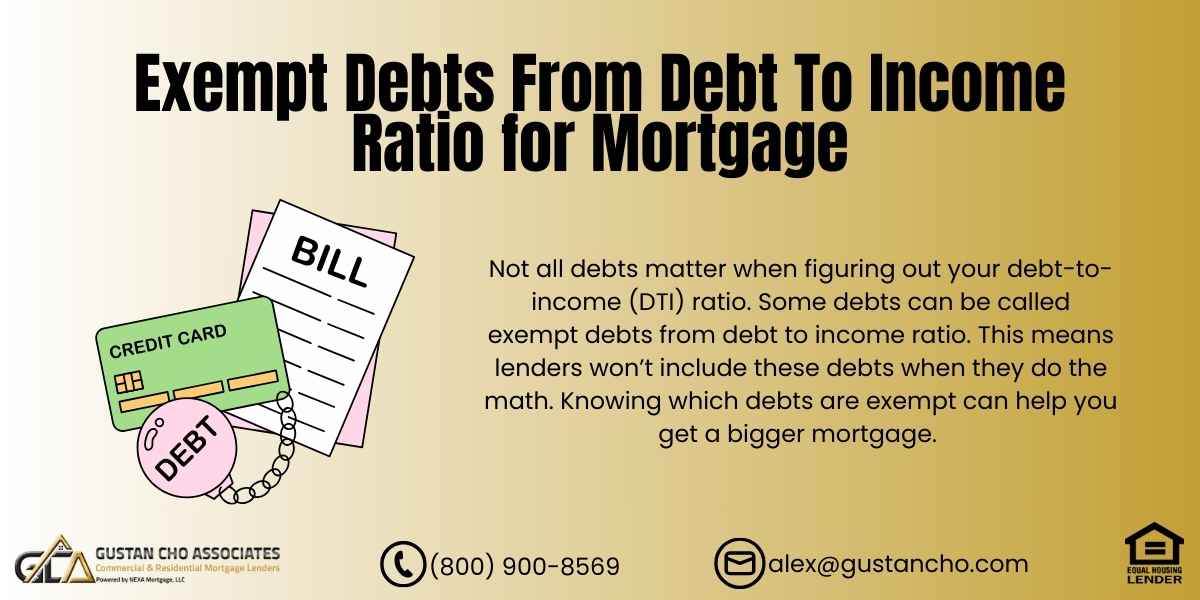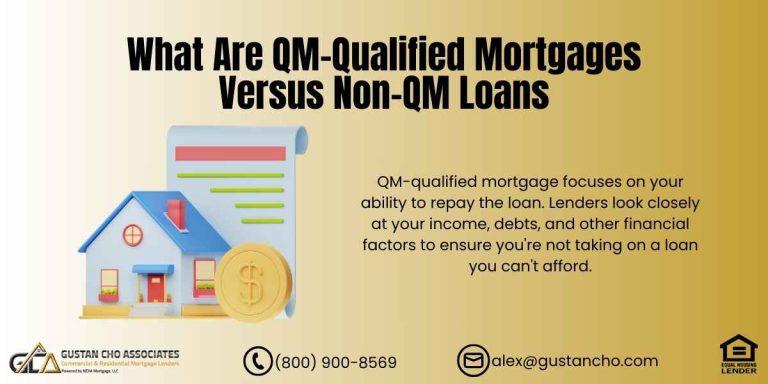Getting approved for a mortgage isn’t just about your income and credit score. A huge factor lenders look at is your Debt-to-Income ratio (DTI). But did you know some debts don’t even count against you when lenders figure out your DTI? Understanding exempt debts from debt to income ratio can significantly impact your mortgage application. Let’s simplify this concept for clarity.
What is Debt-to-Income Ratio?
First things first—what exactly is the debt to income ratio? The debt to income ratio shows how much of your money goes to monthly paying debts. To figure it out, lenders look at all the minimum payments you must make, like credit cards, car loans, student loans, and any support payments. They add these amounts together and then divide them by your total monthly income before taxes.
Exempt Debts from Debt to Income Ratio: How Does It Work?
Not all debts matter when figuring out your debt-to-income (DTI) ratio. Some debts can be called exempt debts from debt to income ratio. This means lenders won’t include these debts when they do the math. Knowing which debts are exempt can help you get a bigger mortgage. So, it’s smart to learn about them!
Take First Step Toward Making Your Dream A Reality
Apply Now And Get recommendations From Loan Experts
Which Debts Can Be Exempt?
When looking at your debt-to-income ratio, some debts can be exempt, meaning they don’t count against you. Knowing which debts can be exempt is important because it can help make your financial situation look better. In this guide, we will go over some common types of exempt debts from debt to income ratio that you might have.
1. Debts Paid by Someone Else
If someone else pays a debt that’s in your name, lenders can exempt that debt. This often applies to student loans or car payments. But here’s the catch—you must prove it.
You’ll need to show:
- 12 months of canceled checks, or
- 12 months of bank statements from the person making payments
For example, say you have student loans, but your parents have been paying them. By providing the lender with your parents’ payment history, that debt becomes exempt.
2. Co-signed Debts
Many people help family members by co-signing loans. If you’re a co-signer and someone else makes the payments, you can exempt debts from debt to income ratio. This means lenders can ignore that loan when determining how much you can borrow. To accomplish this, it is typically necessary to provide evidence, such as bank statements demonstrating that the main borrower has been making payments for a year.
3. Installment Loans with Few Payments Left
Do you have an installment loan, like an auto loan, that’s almost paid off? If you have fewer than 10 payments left, lenders typically won’t count it against your DTI. But remember, this applies only to loans—not leases. Lenders assume you’ll likely get another one once your lease ends, so leases always count.
How Exempt Debts Help You Qualify for a Mortgage
Removing exempt debts from debt to income ratio calculations lowers your DTI significantly. A lower DTI means:
- Better odds of mortgage approval
- Ability to qualify for higher loan amounts
- Potentially better mortgage terms
Imagine your monthly gross income is $6,000. Your debts (car payments, student loans, credit cards) total $3,000 monthly. Without exemptions, your DTI is 50%. But, if your parents pay your $600 student loan, exempting it drops your monthly debts to $2,400. Now, your DTI falls to 40%, making you much more attractive to lenders.
Mortgage Guidelines and DTI Limits for 2024-2025
Here’s a quick look at recent updates to DTI guidelines by loan type:
- FHA Loans: Max front-end DTI is 46.9%, max back-end DTI is 56.9%. Borrowers can go up to 50% debt to income ratios on Manual Underwrites with compensating factors.
- Conventional Loans (Fannie Mae & Freddie Mac): Max DTI typically capped at 50%
- USDA Loans: Front-end cap 29%, back-end cap 41%
- VA Loans: No maximum DTI cap, as long as the borrower receives automated approval
- Non-QM Loans: Generally capped at 50%
Understanding exempt debts from debt to income ratio rules helps borrowers stay within these guidelines.
Real-Life Examples of Exempt Debts in Action
Let’s look at a quick example:
Case 1: Sara wants to buy her first home. She earns $7,000 monthly but carries several debts:
- Car Loan: $400/month
- Student Loan: $500/month (paid by her dad)
- Credit Cards: $300/month
Initially, her total debt was $1,200/month, giving her a DTI of 17% (excellent). But without knowing exempt rules, Sara might count the student loan payments against her. By proving that her dad pays the student loans, $500 is exempt, significantly strengthening her mortgage approval chances.
Case 2: Mike helped his son get a car loan by co-signing, which means he promised to pay if his son didn’t. The loan costs $450 each month. Now, Mike wants to refinance his house to get a better loan, but he is worried about his debt-to-income ratio (DTI).
To improve his DTI, Mike shows proof that his son makes the car loan payments. Because of this, the bank can exempt debts from debt to income ratio, which means they don’t count the $450 against him. This lowers Mike’s monthly debts, improves his DTI, and helps him qualify easily for refinancing.
Gustan Cho Associates: Making Mortgages Easier
At Gustan Cho Associates, we specialize in mortgages without lender overlays. We strictly follow official FHA, VA, USDA, and Conventional guidelines without additional rules, which makes loans harder to get.
We understand exactly how exempt debts from debt to income ratio work. We guide borrowers step-by-step, helping them gather the proof and documentation required by lenders. We aim to make mortgage approvals smoother and faster, even if your financial situation seems complicated.
Exempt debts, such as certain types of child support or non-recurring obligations, can be excluded from your debt calculations
Apply Now And Get recommendations From Loan Experts
Why Choose Gustan Cho Associates?
- No overlays: We don’t add extra rules, like limiting your DTI further than required.
- Expert Guidance: Clear, easy-to-understand guidance on exempt debts.
- Fast Closings: Our experience streamlines the process, getting you approved faster.
- Nationwide Service: Gustan Cho Associates is licensed nationally, helping borrowers across the U.S.
How to Get Started Today
Do you have questions about exempt debts from debt to income ratio? Not sure if you qualify for a mortgage? Reach out to Gustan Cho Associates.
- Call us: 800-900-8569
- Text us for a fast response
- Email: gcho@gustancho.com
Our expert team will answer your questions, guide you through gathering the necessary documentation, and help secure your mortgage approval.
Final Thoughts
Knowing how to exempt debts from debt to income ratio can be very important. It can help you get approved for a mortgage or a home loan. You may also get better loan terms and borrow more money when you understand this. With the right information and a good lender, you can feel good about making your dream of owning a home come true.
Contact Gustan Cho Associates today and make your home-buying process smoother and more manageable!
Frequently Asked Questions About Exempt Debts from Debt to Income Ratio:
Q: What Does Exempt Debts from Debt to Income Ratio Mean?
A: It means some debts don’t count when lenders add up your monthly debts to see if you qualify for a mortgage.
Q: What Types of Debts Can be Exempt?
A: Debts someone else pays, loans with less than 10 payments left, or debts you co-signed but don’t pay can be exempt.
Q: How do I Prove Someone Else Pays My Debt?
A: You’ll need bank statements or canceled checks showing they made payments for at least one year.
Q: Can My Car Lease Payments be Exempt Debts from Debt to Income Ratio?
A: No, car leases always count because lenders expect you’ll get another lease when the current one ends.
Q: Do Student Loans Count Against My DTI if My Parents Pay Them?
A: If you show proof your parents paid your student loans for at least 12 months, they can be exempt.
Q: Does Co-Signing a Loan Always Affect My DTI?
A: Not if the primary borrower makes the payments and you provide proof they’ve done so for the last year.
Q: How Can Exempt Debts from Debt to Income Ratio Help Me?
A: They lower your DTI, helping you qualify for a larger mortgage or better terms.
Q: Will Gustan Cho Associates Help Me Figure Out Exempt Debts?
A: Yes! We’ll guide you through the process and help you gather the right proof.
Q: Can a Debt with Fewer than 10 Payments Left be Exempt?
A: Yes, installment loans like auto loans with under 10 payments left are usually exempt.
Q: Do Exempt Debts from Debt to Income Ratio Rules Apply to All Mortgages?
A: Yes, FHA, VA, USDA, conventional, and non-QM loans allow certain debts to be exempt, making them easier to qualify for.
This blog about “Exempt Debts From Debt To Income Ratio for Mortgage” was updated on March 21st, 2025.
Benefit from FHA, VA, or conventional loan programs with flexible underwriting guidelines
Apply Now And Get Pre-Approved Faster










